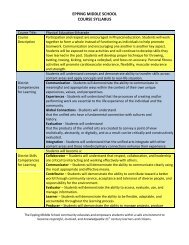Reading Standards for Informational Text & Literature - SAU 14
Reading Standards for Informational Text & Literature - SAU 14
Reading Standards for Informational Text & Literature - SAU 14
Create successful ePaper yourself
Turn your PDF publications into a flip-book with our unique Google optimized e-Paper software.
Integration<br />
of Knowledge<br />
and Ideas<br />
Range of<br />
<strong>Reading</strong> and<br />
Level of <strong>Text</strong><br />
Complexity<br />
Identify author’s point of<br />
view or purpose and<br />
explain how it shows in<br />
the text<br />
Understand in<strong>for</strong>mation<br />
presented in <strong>for</strong>ms other<br />
than words<br />
Find arguments in text<br />
and determine if they are<br />
supported by facts<br />
Compare different<br />
authors’ presentations of<br />
facts on the same subject<br />
Read and understand<br />
literary non-fiction<br />
proficiently<br />
State the author’s<br />
purpose and show how it<br />
differs from other points<br />
of view<br />
Compare and contrast<br />
audio or visual versions of<br />
a text to the text itself<br />
Determine if evidence of<br />
arguments in a text<br />
supports the argument<br />
See if two or more<br />
authors writing about the<br />
same topic offer different<br />
points of view<br />
Read and understand<br />
literary non-fiction<br />
proficiently<br />
develop a main concept.<br />
Determine the author’s<br />
point of view and show<br />
how the author reacts to<br />
other points of view<br />
Show positive or negative<br />
points about using<br />
different types of media<br />
to present an idea<br />
Look at an argument and<br />
decide if the evidence is<br />
valid and find evidence<br />
that is not valid<br />
Look at two or more<br />
pieces of writing on the<br />
same topic and show<br />
where they agree or<br />
disagree<br />
Read and understand<br />
literary non-fiction<br />
proficiently<br />
High School<br />
Grades 9 and 10 Grades 11 and 12<br />
Key Ideas<br />
and details<br />
Craft and<br />
structure<br />
State what the text says and use<br />
evidence to support conclusions and<br />
inferences<br />
Summarize text by pointing out the main<br />
idea and tracing its development<br />
Analyze how ideas and events are<br />
introduced and developed<br />
Show how word choice affects tone<br />
through figurative, connotative, and<br />
technical meanings<br />
Understand how an author’s ideas or<br />
claims are developed<br />
Recognize the author’s point of view and<br />
Recognize when and infer from matters<br />
(that are) left uncertain<br />
Recognize multiple central ideas<br />
Analyze how ideas and events interact<br />
and develop over the course of a text<br />
Understand how the author refines the<br />
meaning of key terms<br />
Evaluate the effectiveness of an<br />
argument’s structure<br />
Analyze how the rhetorical structures of<br />
<strong>Reading</strong> <strong>Standards</strong> – In<strong>for</strong>mational <strong>Text</strong> and <strong>Literature</strong> Epping School District Page 7 of 16
















